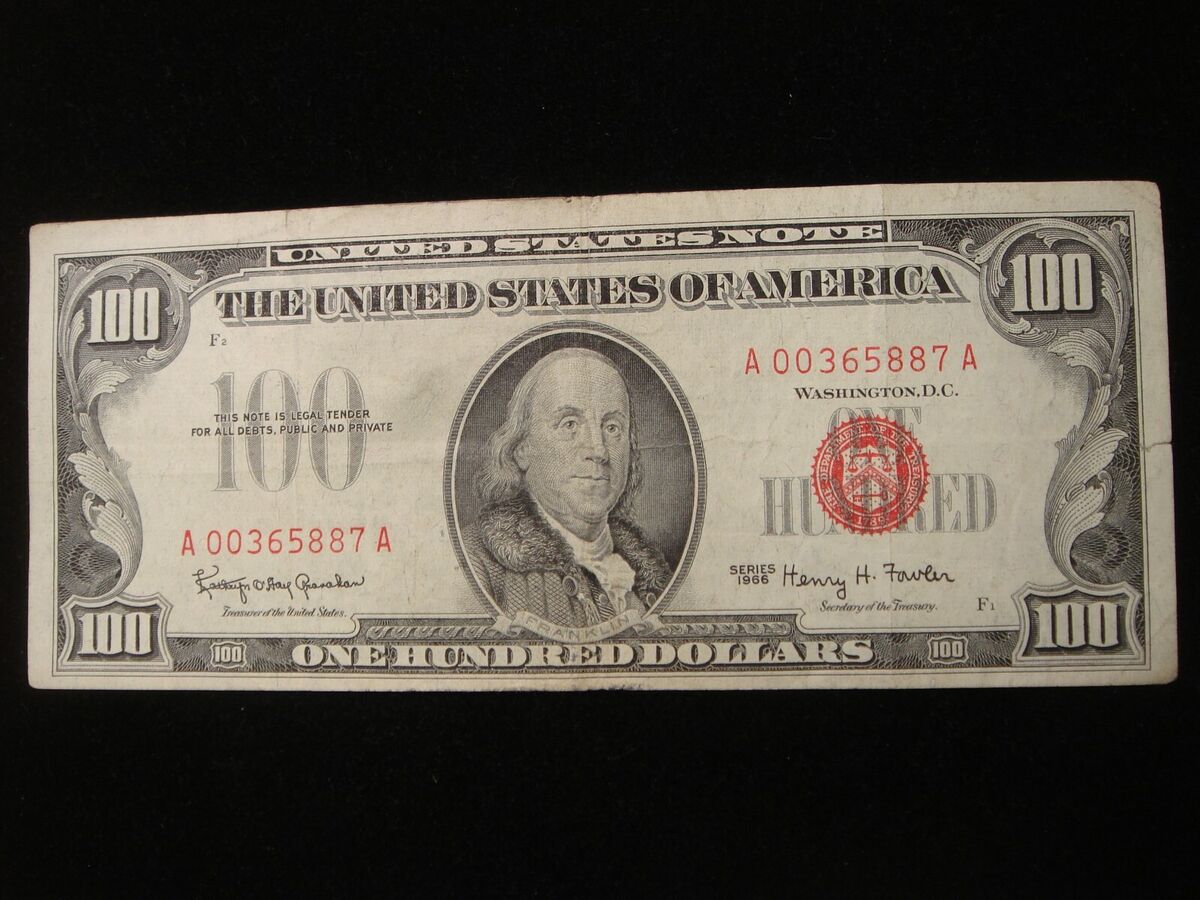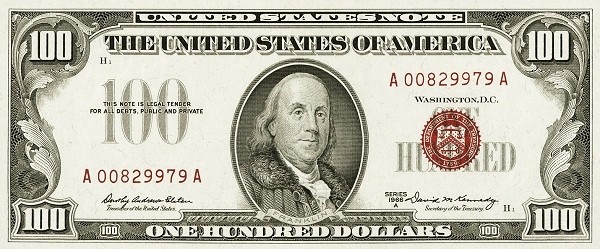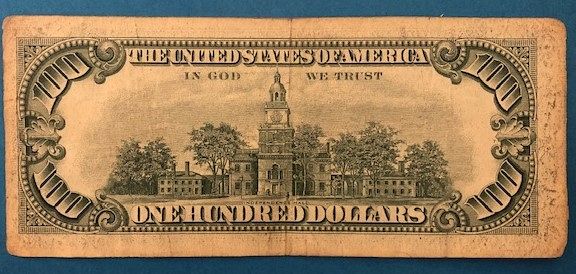The 1966 100 dollar bill is a significant piece of U.S. currency with notable collector interest, offering a glimpse into the history and evolution of American paper money. As a part of the “Series 1966” issued by the U.S. Treasury, these bills feature distinct characteristics that make them stand out, including a unique red seal and serial numbers.
This article provides a detailed exploration of the 1966 100 dollar bill value—how much it is worth, how different grades impact the value, and what sets apart rarer notes such as star notes.

If you’re considering selling or acquiring these bills, understanding the factors that influence their worth is crucial.
Overview Of The 1966 $100 Bill
The 1966 one hundred dollar bill holds historical significance and a distinct place in American currency collection. The bill belongs to a series of U.S. Notes that were issued as legal tender, with distinctive red seals and serial numbers.
These bills were initially printed for circulation in the mid-1960s, and their value can be considerably higher today depending on their condition and the specific series.
The most prominent feature of the 1966 $100 bill is its red seal, a distinguishing characteristic that separates it from modern $100 bills which use blue seals.
The design itself features the portrait of Benjamin Franklin, an iconic symbol of American currency. However, these bills are now considered to be part of the past, and collectors prize them for their rarity and unique characteristics.
Key Specifications of the 1966 $100 Bill
Before diving into the details of the 1966 100 dollar bill value, it’s essential to understand the specifications of this currency:
- Denomination: $100 USD
- Type: Legal Tender Note
- Seal Color: Red (a significant distinction from the Federal Reserve Notes of the same period)
- Series: 1966, 1966A
- Portrait: Benjamin Franklin
- Size: 6.14 inches by 2.61 inches (standard U.S. paper money size)
These bills were issued by the U.S. Treasury as part of the “Series 1966,” which was a transitional design between the old U.S. Notes and the newer Federal Reserve Notes that would dominate later years.
Their red seals make them stand out and contribute to their value among collectors today.
How Much Is A 1966 $100 Bill Worth?
The 1966 100 dollar bill value fluctuates depending on various factors, with the bill’s condition being one of the most crucial. These factors determine how much a collector or investor is willing to pay for the bill.

The price range can vary greatly depending on whether the bill is circulated, in excellent condition, or in mint condition. Here’s a breakdown of what you can expect:
Series 1966 $100 Bill Value:
- Very Fine Condition: $160–$200
- Extremely Fine Condition: $225–$275
- Uncirculated (MS 63): $450–$825
Series 1966A $100 Bill Value:
- Very Fine Condition: $225
- Extremely Fine Condition: $275–$325
- Uncirculated (MS 63): $825–$1,200
These values represent a general estimation, and prices can change depending on market trends, rarity, and demand. A well-preserved 1966 $100 bill in excellent condition could be worth much more than its face value.
The Role Of Star Notes in the 1966 $100 Bill Value
Star notes are an essential aspect when it comes to determining the 1966 100 dollar bill value. These bills were produced as replacements for currency that had printing errors or was damaged during the production process. Each star note features a star symbol before the serial number, marking it as a replacement note.
Given their rarity, star notes typically have higher values than regular notes. For example, the value of a 1966 100 dollar star bill can be:
- Very Fine Condition: $400
- Extremely Fine Condition: $550
- Uncirculated (MS 63): $1,250
The rarity of star notes increases their appeal to collectors, and their value is significantly higher than that of standard series notes.
The Importance of Condition in Determining Value
The grading system plays a crucial role in determining the value of a one hundred dollar bill from 1966. A bill’s grade is based on its condition and reflects how much wear and tear it has sustained over the years. The higher the grade, the more valuable the note.
Here’s a breakdown of how different grades affect the 1966 100 dollar bill value:
- Very Fine: A note in very fine condition has visible signs of wear but is still relatively crisp. There may be some light creases, folds, or smudges, but the overall integrity of the bill remains intact.
- Extremely Fine: A bill in extremely fine condition will have minimal wear and be close to its original crispness. Any creases or folds will be minor, and the note should have no discoloration, tears, or stains.
- Uncirculated (MS 63): A note that has never been in circulation or is in near-perfect condition is classified as uncirculated. It will show no signs of use and retains all of its original crispness and sharp details.
It’s important to note that even a 100 dollar bill in relatively good condition can have a substantial value, particularly if it’s part of a rare series or a star note.
The Impact of Serial Numbers
While serial numbers are generally a security feature on U.S. currency, they can occasionally influence a bill’s value. Special patterns or low serial numbers (such as 00000001) may appeal to collectors, leading them to pay a premium for these unique bills.
However, in most cases, serial numbers do not significantly affect the overall 1966 100 dollar bill value.
If you happen to have a bill with an interesting serial number, such as repeating digits or a low number, you may find that it increases its worth among collectors who value such rarities.
The Significance of Red Printing and U.S. Notes
The red seal and serial numbers on the 1966 100 dollar bill are an important part of its history. These bills were part of the U.S. Notes series, which were printed until 1966. U.S. Notes were distinct from the Federal Reserve Notes that followed and had a red seal, which is no longer seen on modern currency.
The 1966A series marks the last of the U.S. Notes before the switch to Federal Reserve Notes.
The rarity of these notes, combined with their historical context, adds to their collector appeal. U.S. Notes are no longer issued, which makes these bills even more sought after by currency collectors today.
Conclusion: The 1966 100 Dollar Bill Value
The 1966 100 dollar bill value is influenced by several factors, including the bill’s condition, whether it is a star note, and its rarity. Depending on these factors, the value can range from $125 to $1,250 or more.
Understanding the value of these notes and how to assess their worth is crucial for making informed purchasing or selling decisions.
If you are lucky enough to own a well-preserved one hundred dollar bill from 1966, it could be a valuable addition to your collection, especially if it’s part of the rare 1966A series or a star note. As time passes, the demand for vintage U.S. currency will likely continue to rise, making these bills not just a piece of American history but also a solid investment for those who understand their value.

